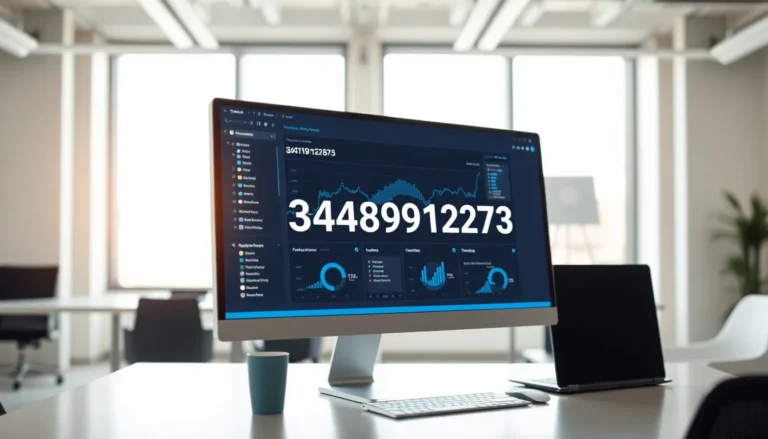In the fast-paced world of economics, the Conference Board Leading Economic Index (LEI) stands out like a lighthouse in a foggy sea. It’s the crystal ball that helps businesses and policymakers predict economic trends before they hit the shores. Imagine having a tool that not only tells you where the economy is headed but also gives you a heads-up on when to stock up on those inflatable pool toys or perhaps invest in a cozy winter jacket.
Table of Contents
ToggleOverview of Conference Board LEI
The Conference Board Leading Economic Index (LEI) serves as a vital indicator of future economic activity. Its compilation includes various components that reflect current and anticipated market conditions.
Definition and Purpose
The Conference Board LEI consists of ten economic indicators that predict changes in the business cycle. These components include average weekly hours worked in manufacturing, new orders for consumer goods, and stock prices. By measuring these indicators, businesses and policymakers can gauge economic momentum, allowing for informed decisions. Understanding the LEI fosters quick responses to potential shifts in the economy, helping to adapt strategies to changing circumstances.
Importance in Economic Forecasting
The LEI significantly influences economic forecasting by indicating turning points in economic activity. Analysts utilize the data to predict business cycles, aiding in investment decisions and policy formulation. A consistent rise in the LEI suggests future economic expansion, while a decline indicates potential contraction. Policymakers rely on these insights to make informed choices regarding interest rates and fiscal policies. Overall, the LEI provides a reliable gauge, assisting various sectors in navigating economic fluctuations.
Components of Conference Board LEI

The Conference Board Leading Economic Index (LEI) consists of several key components that provide insights into future economic trends. These elements reflect various aspects of economic health and allow for accurate predictions.
Leading Economic Indicators
Leading economic indicators play a crucial role in shaping the LEI. The index includes ten specific measures such as average weekly hours worked, new orders for consumer goods, and stock prices. Other components include consumer expectations, supplier delivery times, and building permits. Each indicator serves a distinct purpose and contributes to overall predictions. For instance, a rise in building permits suggests increased construction activity, while higher stock prices often signal investor confidence. Collectively, these indicators form a comprehensive picture, helping businesses and policymakers anticipate shifts in the economic landscape.
Data Collection Methods
Data collection methods ensure the accuracy and relevance of the LEI. The Conference Board gathers data from various sources, including government reports, surveys, and private sector data. For example, information on manufacturing hours comes from the Bureau of Labor Statistics, while consumer sentiment data is sourced from surveys conducted by the Conference Board itself. By employing diverse data collection techniques, the LEI maintains its credibility as a predictive tool. This multifaceted approach allows for timely updates and reflects real-time economic conditions, offering valuable insights for decision-making.
How to Interpret Conference Board LEI
Interpreting the Conference Board Leading Economic Index (LEI) provides valuable insights into economic trends. Understanding its components and analyzing the data helps forecast economic conditions.
Analyzing Trends
Identifying trends in the LEI enables observers to monitor economic health. A consistent increase in the index usually points to future economic growth. Conversely, persistent declines signal potential contraction. Each monthly release provides a snapshot of trends that inform investors and policymakers. The LEI reflects changes in ten key indicators, including stock prices and manufacturing hours. Tracking these components equips users with information to anticipate shifts in market dynamics.
Implications for Businesses
Businesses benefit from LEI data when making strategic decisions. Anticipating economic changes allows for better planning regarding inventory and staffing. When the index shows growth, companies often increase production to meet rising demand. In contrast, a declining LEI might prompt businesses to reassess their strategies and cut costs. Decision-makers can utilize LEI trends to gauge consumer confidence and adjust marketing efforts effectively. Understanding these implications enhances competitive positioning in fluctuating markets.
Applications of Conference Board LEI
The Conference Board Leading Economic Index (LEI) plays a significant role in various applications, particularly in policy making and investment strategies.
Policy Making
Data from the LEI informs policymakers about potential economic trends, guiding decisions that affect fiscal and monetary policies. Tracking the LEI helps understand shifts in economic activity, which can prompt changes in government spending or taxation strategies. A rising index often indicates a need for expansionary policies, while a declining trend may lead to contractionary measures. Policymakers rely on the LEI to align their initiatives with current and projected economic conditions, ensuring timely interventions that promote stability and growth.
Investment Strategies
Investors utilize the LEI as a key tool for formulating strategies. By analyzing the index’s movements, they gain insights into future market conditions, enabling optimal timing for investments. A consistently rising LEI suggests robust economic growth, encouraging investments in equities and real estate. Conversely, a decline may prompt a reevaluation of risk, steering investors toward safer assets such as bonds or commodities. Utilizing LEI data allows investors to align their portfolios with anticipated economic shifts, ultimately enhancing returns and minimizing losses.
The Conference Board Leading Economic Index is an essential resource for understanding future economic conditions. By analyzing its components and trends businesses and policymakers can make informed decisions that enhance their strategies. The LEI’s ability to signal potential expansions or contractions provides a significant advantage in navigating economic uncertainties.
As the LEI continues to evolve with real-time data it remains a vital tool for anticipating shifts in the market. Leveraging this index allows organizations to position themselves effectively in a dynamic economic landscape. Ultimately the insights gained from the LEI empower stakeholders to respond proactively fostering stability and growth in their respective sectors.








